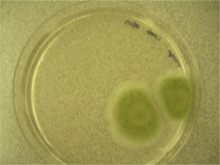Penicillium expansum
| Penicillium expansum | |
|---|---|
 |
|
| Scientific classification | |
| Kingdom: | Fungi |
| Phylum: | Ascomycota |
| Class: | Eurotiomycetes |
| Order: | Eurotiales |
| Family: | Trichocomaceae |
| Genus: | Penicillium |
| Species: | P. expansum |
| Binomial name | |
|
Penicillium expansum Link, (1809) |
|
| Synonyms | |
|
Penicillium crustaceum Link, (1809) |
|
Penicillium crustaceum Link, (1809)
Penicillium glaucum Stoll, (1809)
Penicillium expansum is one of the most prevalent post harvest rots that infects apples.
Although it is a major economical problem in apples, this plant pathogen can be isolated from a wide host range, including pears, strawberries, tomatoes, corn, and rice. This mold also produces the carcinogenic metabolite patulin, a neurotoxin that is harmful in apple juice and apple products. Patulin is produced by the fungi when it rots the host. The levels of patulin in food products is a health concern because many are consumed by young children. In addition, a second secondary metabolite citrinin is produced as well. Furthermore, it is also one of the oldest known species of Penicillium recorded and has been used for continuous research and studies. It is a psychrophilic blue mold and ubiquitous throughout the soil.
Penicillium expansum is a post harvest rot that affects a number of different hosts, including citrus fruits, apples, pears and cherries.
While P. expansum has a wide and variable host range, the symptoms are very similar across all hosts. With a P. expansum infection, initial infected spots appear post harvest while fruit is in storage, and a sharp visible contrast can be seen between diseased and healthy tissue. Often, decaying tissue can be easily "scooped" out of the surrounding healthy tissue. The initial infected spots that appear will be light brownish in color, and the tissue beneath these brown spots will be soft and mushy, and have a watery consistency. The initial infection sites often occur in injured areas of the fruit, somewhere that has been punctured, bruised or otherwise injured. Blue to bluish green spore masses will appear on the infected fruit, starting with the older lesions. These spore masses will initially appear as white mycelium on the surface of the infected fruit, then turn blue to bluish green in color. Fruit affected by P.expansum can be expected to have an earthy, musty odor to it. Lesions resulting from wounds can be expected to be one to one and a quarter inches in diameter eight to ten weeks after infection if kept under cold storage conditions. Age factors into P.expansum infection in that overripe or mature fruits are most susceptible to infection, while those picked underripe are less likely to become infected with P.expansum.
In apples, the colors of the lesions may vary in color slightly with variety, from lighter-brown on green and yellow varieties to dark-brown on the deeper-red and other darker-color varieties. Varieties particularly susceptible to P.expansum infection include McIntosh, Golden Supreme, and Golden delicious.
...
Wikipedia
